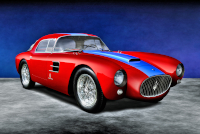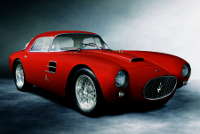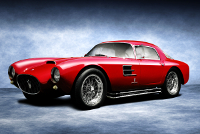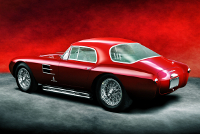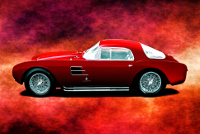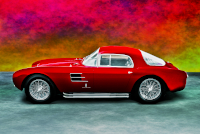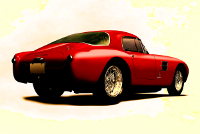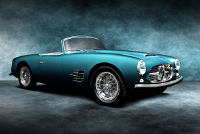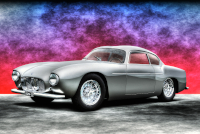Location:
Elegance at Hershey, 2012
Radnor Hunt Concours d'Elegance, 2007
Owner: J.W. Marriott, Jr. | Bethesda, Maryland
Prologue:
When I first photographed the A6GCS/53 Pinin Farina Berlinetta, I did not know any of these rare cars lived in the region; to see one in the flesh was a sublime surprise.
Once I put together a rudimentary profile, the historical details only enhanced the encounter. Back then, one needed to dig to suss out the order and arrangement of the four original bodies and six chassis. Now the story seems well enough known.
So today's revision catches up on 15 years of delinquent meandering, a story I left untouched for some while, in need of accuracy, clarity, and context. What we now have is a thorough examination of the series given proper support. I can only wish that we'll receive the benefit of another encounter to broaden the visual selection, which, as it stands, dates all the way back to 2007, save for one image collected in 2012.
Chassis #2089 began life a decorated racer—a Mille Miglia and Targa Florio class winner—later clothed in an original Pinin Farina body that is the herald for Italian GT design trends through to the next decade. Of the six extant A6GCS/53 Pinin Farina Berlinetta cars, #2089 is the highest chassis number and carries the last of the original series of four bodies (first fitted to #2060). Though not a matching car, both chassis and body are original, and no other A6GCS/53 chassis to wear Pinin Farina coachwork was as successful in racing guise.
In conjunction with the latest revision, I prepared three additional illustrations. The foremost of these images is a refinished quarter shot depicting Pinin Farina's coachwork as fitted to chassis #2060, originally painted rosso corsa with a blue stripe.
- - - - - - - - - -
► Image Source: Nikon D200 (10.2 MP)
References:
- Bäumer, Walter; Blachette, Jean-François. "Maserati A6GCS" Dalton Watson Fine Books, Deerfield, IL. 2022, page 308-309
- Cancellieri, Gianni; Dal Monte, Luca; De Agostini, Cesare; Ramaciotti, Lorenzo. (English translation by Neil Davenport and Robert Newman.) "Maserati, A Century of History: The Official Book" Giorgio Nada Editore, Vimodrone, Milano, Italia. 2013, page 58, 105-106, 117-118, 122-123, 287
- Crump, Richard; de la Rive Box, Rob. "Maserati Sports, Racing and GT Cars from 1926" Third Edition, G.T. Foulis & Company for Haynes Publishing Group PLC, Somerset, England. 1992, page 121
- Carrozzieri Italiani: A good survey of the six A6GCS/53 Pinin Farina Berlinetta cars.
- UltimateCarPage: Depicting five of the six extant A6GCS/53 Pinin Farina Berlinetta cars, with eye candy and information besides. Work by Wouter Melissen, July 28, 2014.
- Petrolicious: "Battista Pininfarina, The Designer's Story" by Johni Parker, May 22, 2014.
- Barchetta: A fine registry of Ferrari and Maserati cars by serial number.
The A6 begins in 1946 with a svelte 1488 cc berlinetta, the A6 1500, which marks the transition point between Maserati's strictly racing past and its road car future.
The A6GCS remains pure racing car, and the A6GCS/53 denotes a technical evolution over the first A6GCS sports-racing series. Derived from the single-seat Formula Two A6GCM, the motor remains a 1,986 cc inline 6-cylinder, but takes on a variety of improvements greater flexibility and power. In this respect, the A6GCS is counterpoint to the Ferrari 500—a model also powered by a motor developed for Formula Two racing, built into a series of berlinetta and spider-bodied sports cars.
Guglielmo Dei and the Pinin Farina Maserati Cars
Lorenzo Ramaciotti supposes that Pinin Farina are yet interested in clothing the updated A6GCS/53, as they have followed the A6 trajectory since its inception in 1946. On Pinin Farina's alliance with Ferrari, which begins in 1952, Ramaciotti writes, "the stylist felt it was not fair to be active on two fronts that were so opposed to each other. However, it did not pull back from constructing four A6GCSs using the ploy of having them ordered by Mimmo Dei, the head of the Centro Sud racing team."
The tone suggests Guglielmo Dei became involved as a workaround to further the partnership between Maserati and Pinin Farina, and perhaps not as a function of originating the concept purely on his own accord.
In the end, the racing attitude of these A6GCS/53 berlinetta cars befits a racing team, but benefits the coachbuilder moreso than the drivers. Ramaciotti points out, "The story of the four cars is also a parable of that which happens when an aspect of a project abuses the others: they were beautiful, certainly, but no way were they functional. The cars were uncomfortable, swelteringly hot, not very aerodynamic; eventually those dazzling Pinin Farina bodies were taken off the chassis and replaced by a more common but practical Fantuzzi open top barchetta design."
Nevertheless, the project begins with six chassis sequestered for Pinin Farina treatment by Guglielmo Dei, but the coachbuilder manages to finish only four. The four chassis to receive original coachwork are, #2056, #2057, #2059, and #2060.
As Ramaciotti notes, two of the bodies quickly change about, finding their way onto other competition A6GCS/53 chassis. However, that the berlinetta designs are so remarkable ensures their preservation—no less because the bodies return to Maserati, who would not waste the material. And rather than bid them goodbye for their competitive deficiencies, eventual owners of the two chassis that received secondary Fantuzzi coachwork opine for the originals. So the body and chassis swap practice does eventually result in a series of six total cars.
The Pinin Farina A6GCS/53, Chassis by Chassis
Each of the cars is slightly different, yet they also express two distinct Pinin Farina styling exercises. The first is a tidy berlinetta with a gentle, suggestive fin treatment in the rear quarters. And the second is a daring low-hood style with a split windscreen and cut-down rounded tail. The ultimate configuration among these chassis works out as follows:
- Chassis #2056: The first chassis wears a tidy GT body (similar to #2089 depicted here), but omits the bonnet scoop and positions the filler cap in a high position on the driver's side butress, as befits competition. The car is rosso corsa. Count Paolo Gravina di Catania races #2056 in the 1954 Giro di Sicilia but suffers a crash. His co-driver, whose name does not readily appear in race records, dies in the accident. Chassis #2056 returns to Maserati and sits abandoned until its restoration in 1991. This chassis is one of two to retain its original Pinin Farina coachwork.
- Chassis #2057 (now #2086): The second chassis originally wears the low-hood body, which Maserati display at the 1954 Turin Motor Show alongside an A6G/54 Berlinetta by Frua and an A6GCS sports-racing barchetta. The coachwork is two-tone azzurro and blu. Pietro Palmieri races the car in the Mille Miglia and Giro di Umbria, but finds the noise and heat insufferable. The car sheds its berlinetta body for a Fantuzzi spider body, and takes chassis #2086 in the process. The original body survives, eventually fitted to chassis #2070. Now known as chassis #2086, subsequent owner Franco Lombardi commissions Autorestauro di Giordanengo Giovanni & Figli to build a reproduction body based on #2056. Giordanengo complete two reproductions. The front wings appear slightly more angular, though the shape is still rather extraordinary. The car is rosso corsa, and of a slightly richer hue than the original red cars.
- Chassis #2059: The third chassis wears a GT body in the form of #2056, but with a bonnet scoop and a perspex wind deflector. The car is rosso corsa with a white stripe, and appears at the 1954 Paris Motor Show. Count Alberto Magi Diligenti purchases #2059 and campaigns the car at Siena-Firenze and the Mille Miglia. As the lone chassis to wear its original coachwork and survive without incident, #2059 is the most complete and unbothered of the six Pinin Farina berlinetta cars.
- Chassis #2060: The fourth chassis originally wears the coachwork now seen on #2089, depicted here. The car is rosso corsa, but originally with a blue stripe. Mimmo Dei's Centro Sud owns the car and, as with #2057, changes the berlinetta coachwork for a Fantuzzi spider body. During the 1970s, owner Count Hubertus Von Dönhoff, a longtime racing campaigner of historic Maserati cars, sets about reclaiming Pinin Farina coachwork for chassis #2060, seeking either the car's original body or that of #2057. Unable to acquire either, he commissions Church Green Engineering, a UK Maserati specialist, to craft a replica body. The replica follows the low-hood plan of #2057, finished in silver flake.
- Chassis #2070: The fifth car is of course a donor chassis wearing the original two-tone blue Turin Motor Show coachwork of chassis #2057/2086. In its own right, #2070 is an original A6GCS/53 Fantuzzi Spider first owned by Anna Maria Peduzzi. Known as "la Marocchina," Peduzzi raced for Alfa Romeo's Scuderia Ferrari in the classic era, and continues to campaign Ferrari and Maserati sports-racing cars after the war.
- Chassis #2089: The sixth and final car appears here in our profile. Like #2070, chassis #2089 is an original A6GCS/53 Fantuzzi Spider, this one acquired and raced by Francesco Giardini in 1955. That year, he takes class wins in the Mille Miglia (placing fourth overall) and in the Targa Florio, which makes #2089 the most decorated of the six chassis. In 1957, a shunt at the Salita delle Torricelle hillclimb with Antonio de Berardinis at the wheel scuppers the front end. The car returns to Maserati, who rebuild #2089 with the coachwork from chassis #2060, which Mimmo Dei has stored in Modena.
Perhaps the oddity that brings unnecessary confusion to this bit of forensics is that the two chassis that lost their original coachwork and later gained reproduction bodies also switched the style of those bodies. Chassis #2057 (now #2086) began with the low-hood coupe style, but now wears a copy of the more gentile GT-type body. And chassis #2060 began with the GT-type body, but now wears a copy of the low-hood coupe.
This fact is neither here nor there, only a curiousity in that the owners of those two chassis wished to switch styles. Likely there is more to the story, perhaps to do with access to the original artefacts or the capabilities of the restoration shops. Whatever the case, we're privileged to have been given the six cars originally promised.
Motor: 1,985.6 cc straight 6-cylinder, cast-iron block and aluminum alloy head | 76.5 mm x 72 mm | 8.75:1 compression
In 1952, chief technician Vittorio Bellentani, along with Gioacchino Colombo (him of Ferrari 250 fame), prepare the second series A6GCS. The block uses a shorter stroke at 76.5 x 72 mm, tested in various guises in the Formula Two A6GCM. This new A6GCS/53 motor uses revised valve gear, but more critically reduces the compression ratio. Against the second series A6GCM compression of 13.5:1, the A6GCS/53 runs 8.75:1 compression, the advantage being flexibility to operate on commericial petrol, rather than a racing mix. Even so, refinement to the valve gear and ignition improve output over the A6GCS by 38-40 bhp. At this time, Colombo also pens the clever frog-eyed sports-racing spider body, as built by Fantuzzi and Fiandri.
Valvetrain: DOHC, 2 valves per cylinder, gear driven
Aspiration: triple Weber 40 DCOE/A3 carburetors
To attempt an explanation of the carburetor set-up, 'DCO' stands for 'doppio corpo orizontale,' or 'double horizontal body,' which identifies these units as sidedraft carbs. The 'E' is a type specification, and the 'A3' likely a production variant for Maserati.
Power: 170 bhp at 7,300 rpm
Drivetrain: 4-speed gearbox, rear-wheel drive
Front Suspension: independent wishbones with coil springs, Houdaille dampers, and anti-roll bar
Rear Suspension: live axle with coil springs, Houdaille dampers, and anti-roll bar
Architecture: steel tubular frame with longitudinal and cross-member bracing, aluminum body by Pinin Farina
Kerb Weight: 900 kg (1,984 lbs)
Wheelbase: 2,310 mm (90.94 inches)
0-60: about 7.2 seconds
Top Speed: 210 km/h (130 mph)
Etymology:
The 'A' designation memorializes Alfieri Maserati, the firm's principal founder, a talented engineer and driver who died in 1932. His original concern is Officine Alfieri Maserati, founded in Bologna in 1914. All things Maserati concern family, a title further extended to those close to the brothers, so the primary designation of the firm's first full-production model is not surprising.
The '6' refers to the number of cylinders. The 'G' stands for 'ghisa,' or 'iron' in Italian, denoting the cast-iron block. 'CS' stands for 'corsa sport,' an Italian translation of 'sports-racing.'
The '/53' designation identifies the second series A6GCS, which uses the penultimate development of the Formula Two racing motor of the A6, detuned for sports cars but with updates to the valve gear and ignition.
'Berlinetta' refers to the closed coupé bodywork, a diminutive form of 'berline' derived from the French carriage trade. Pinin Farina provide the coachwork, often interchanged with 'Pininfarina,' though the name does not officially change to one word until 1966. And we note that this is chassis #2089, an original A6GCS/53 with strong racing history, fitted in-period with the original body from chassis #2060.
Ramaciotti also notes that, for shorthand reference, Maserati referred to both the A6GCS and A6GCS/53 as either the 'Sport 2000' or '2000 Sport.'
Figures:
A6 development begins in the late 1940s. The firm experiment with a 1.5-litre racing motor fitted to one-off spyder and berlinetta cars, creating numerous gems of lightweight sports car fantasy. By 1946, Maserati attach the A6 moniker to a dedicated production run, which becomes their first road-going product.
The Barchetta registry lists 214 cars produced among all A6 models, beginning in 1946 and ending in 1957. Of these, 52 are listed as the A6GCS/53.
Of this second series, four cars receive original Pinin Farina berlinetta coachwork, and through the girations explained in our profile that number grows to six total chassis with reproduction variants of the Pinin Farina originals.
Sport Variants: Discerning Styles among the Pinin Farina Maserati A6GCS/53 Berlinetta
Of the six cars circulating today, we see two distinct body styles. In their present configurations, chassis #2056, #2086, #2059, and #2089 wear the GT-type coachwork with gentle tail fin treatment (as depicted here). Chassis #2060 and #2070 wear the more aggressive low-hood coupe coachwork.
In terms of visual dynamics, the predominate GT style carries exquisite proportions offset by dramatic single-seat racing attitude. The nose extends well out and below the headlamps, though this effect is somewhat diminished by the addition of a bonnet scoop, and the nose on chassis #2089 may also be slighter shorter than its predecessors. This open-wheel monoposto approach is therefor most apparent on the early exercises, #2056 and #2059, as well as the low-hood Turin car, #2070. The Giordanengo reproduction also follows suit.
We see a similar use of monoposto style in period sports-racing cars at Lancia, where Pinin Farina drop a Formula One nose deep between the headlamps of the D24, which in turn establishes a strong visual connection to the new D50 F1 car. Later, and perhaps most famously, Scaglietti will demonstrate this concept in its extreme on the 250 Testa Rossa. So these Maserati berlinetta cars point the way, the proportions evident in their fascia giving clear notice of their racing intent.
Another dramatic characteristic of the Pinin Farina A6GCS/53 design is the set-back cabin. Ramaciotti notes that, with the use of a wrap-around windscreen, the A-pillars sit aft of the mid-point of the wheelbase. This long-nose effect applies to all of the cars, but it is most dramatic on the low-hood coupe, chassis #2070, where the chopped roof becomes a sinister canopy tucked into the haunches, flowing into a rounded fastback tail. In contrast, the GT-type hood drops between two modest tail fins, a style that becomes rather standard for the Italian GT car.
GT Precedent: Early Pinin Farina Evidence of the Ferrari GT Concept
Mechanically, the A6GCS/53 fits the mould of the Ferrari 500, a Formula Two platform turned sports-racer. But stylistically, these rare Maserati cars offer sporting juxtaposition to the unique Ferrari 166 Mille Miglia Berlinetta of 1953. That particular gem bears a tidiness of line that even looks the diminutive of the A6GCS/53.
The 166 MM Berlinetta is oval in perspective and in profile—cute before menacing, and undeniably pretty. From these small berlinetta cars to more formidable machinery, we should note that the elegant rounds of this forward-facing headlamp style carry directly to the Ferrari 375 MM, a 1954 design concurrent with the A6GCS/53.
Then by the early 1960s, sports car racing witnesses a flood of Ferrari 250 GT short wheelbase (SWB) berlinetta cars doing the business of front-line motor racing. Particularly speaking of the GT style, these special Maserati berlinetta cars foreshadow that 250 GT SWB Pinin Farina design, now lauded for its simple athleticism. And yet the proportions on the A6GCS/53 appear tighter, prettier in all aspects with more dramatic dips between the nose and the headlamp pods, a perfect balance of aggressive lines and elegant curves. In comparison, the 250 GT SWB Berlinetta clearly shows the girth required to cover a heavier chassis—a car grown-out for good purpose, but without the same delectable execution.
Aural Delight: Engine Note and the Italian Hot Rod Aesthetic
While the A6GCS/53's visual dynamics eclipse Pinin Farina's early attempts on Ferrari chassis, the car's aural capacity easily matches its looks. The sound of a classic Maserati is simultaneously luscious and ripping; it is mean but smooth, like a blues musician who plays with high distortion, but does so with impeccable virtuousity. I'll use the term, 'Italian hot rod,' to underscore the point, and add that perhaps Ferrari's Dino V-6 possesses a similar contradiction of smooth grittiness in its soundtrack.
Sidepipes help, offering a shortcut for the motor's exhalation, while keeping the tail free of the clutter that protrudes from the undercarriage of later Italian hot rods. Notably, the Ferrari 250 SWB falls into this category.
Moniker Homage: The Guglielmo Dei Cars
Note that the chrome script across the boot lid reads 'Guglielmo Dei Roma,' the 'G' looking conspicuously like an 'S.' In the 1950s, Mimmo Dei is the Maserati agent in Rome and head of Scuedria Centro Sud; he facilitates this series of berlinetta cars by Pinin Farina. A few, but not all of the A6GCS/53 Pinin Farina Berlinetta cars wear this script.
Last Updated: Jul 1, 2025

